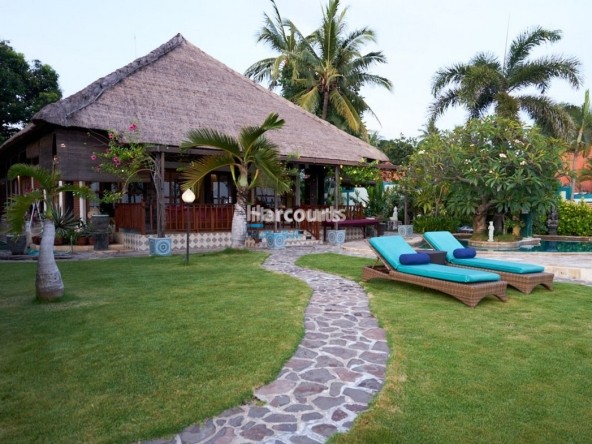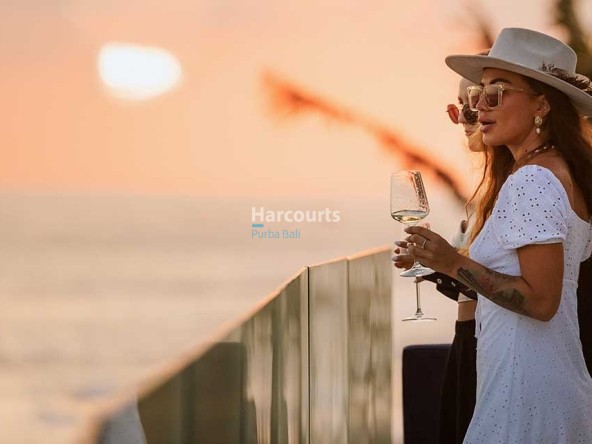In ancient times, it was a dangerous place where great herds of wild banteng and water buffalo roamed free, driven south by population pressure. It served as a hunting ground for pheasant, wild boar and deer, favoured by the rajas of Denpasar and Mengwi. In fact, Bali’s Bukit Peninsula was considered to be so mysterious, foreboding and inhospitable that it became a place of banishment for criminals, undesirables, debtors and political agitators.
Bukit is the Indonesian word for hill, and bar a sliver of land just south of the airport, it would be a separate island. Until the Millennium, the Balinese had little interest in this 140-square-kilometre, lemon-shaped, limestone tableland that dangles like a pendant upon a chain to form the southernmost extremity of the island. A curious, windswept geographical feature, presenting dizzying cliffs, caves and timeworn sea temples, it stands out in sharp contrast to Bali’s lush, alluvial plains.
The dramatic coastline of the Bukit is pounded by Bali’s most challenging surf and in the early ’70s those in search of the perfect wave discovered some thrilling breaks. Bali has subsequently become one of the great surfing meccas of the world. Diehard surfers made their homes on the peninsula, while homestays and thatched beach warungs were built to accommodate and nourish transient surfers. The only other residents of this dry-land outcrop were seaweed farmers, fisherman and cassava farmers, while the only other industry was the mining of blocks of building stone from inland karst quarries. Yet there was little infrastructure, no telephone lines, no electricity, almost no surface water and no streams. Roads were limited, many of the gorgeous beaches were inaccessible, and the only tourist attraction was the 11th century cliff-hanging temple, Pura Luhur Uluwatu.
These days, the Bukit presents a very different image. Extending from Jimbaran to Uluwatu on the southwest tip, and east to Nusa Dua, with the districts of Pecatu and Ungasan at its centre, it is now the most elite and upmarket destination on the island. It is proudly home to many of Bali’s top-end villas and glamorous private estates, as well as a growing collection of splendid resorts and boutique hotels bearing the most eminent global brands.
In the 1970s, Nusa Dua was selected as the location of the most ambitious resort project in Indonesia’s history. Once a wide, airy expanse of coconut groves and land deemed unsuitable for agriculture, this sparsely-populated, flat terrain was chosen for its natural beauty, gorgeous beaches, dry climate and proximity to the airport. Moreover, it was apparent that its relative isolation would cause minimum impact. With help from the World Bank and private developers, and with foreign consultants drawing up the plans, ground was broken for the multimillion dollar project in 1973. Progress was stalled many times, but by 1993, the project had achieved the provincial government’s goal of nine up-market hotels with a total of 2700 rooms and a capacity of nearly 200,000 guests. Today, the Nusa Dua Tourism Resort presents a ribbon-wrapped package, complemented by an air of gentility and order – a 300-hectare tourist enclave of wide paved lanes and manicured gardens, managed by the Indonesia Tourism Development Corporation (ITDC). There are now 19 five-star rated hotels in the enclave offering over 5,000 rooms, bordered by safe, clear waters and clean golden-sand beaches, and supported by a shopping centre, restaurants, a museum, cultural venues, the Nusa Dua Golf and Country Club, BIMC Hospital and two international convention centres. The well-planned infrastructure sheltered the rest of Bali from the damages of mass tourism and avoided the waste problems that plague other areas. As a result, the hotels are the most environmentally-friendly on the island.
The Bukit’s pioneering luxury resort outside of the ITDC complex was Four Seasons at Jimbaran Bay, which opened in 1993, but it was well over a decade before the infrastructure improved sufficiently to sustain the development of remote cliff edge sites. Today, we find internationally-branded resorts such as Banyan Tree, Bulgari, Alila, Radisson Blu, Anantara, Six Senses, Renaissance, Movenpick, Ritz Carlton, and The Apurva Kempinski, together with many prestigious private villas, wedding venues and spas, sophisticated beach clubs, hedonistic clifftop day clubs, three golf courses, and some of Bali’s best fine dining restaurants. Visitors can also enjoy live music venues, a booming café culture, shops, newly accessible beaches such as Pandawa and Melasti, and the world’s second-tallest statue at Garuda Wisnu Kencana (GWK) Cultural Park. A south ring road is in the planning stages with the aim to reduce traffic congestion on the current main roads. It will pass along the cliffs, beaches, land, and sea of the south Bukit peninsular area and the distance will total 33.5 kilometres. The road construction is slated to start in 2020 with the first stage to be completed in 2021 and the second in 2022.
“Some of Europe and Asia’s foremost developers are now looking at securing what may be the last remaining major development plots on the Bukit’s south coast”, says Siti Purba from Harcourts Purba. “There are very few prime cliff-front plots left. In the last 12 months, more cliff-front villas have sold than in all of the previous four years, and it looks like this increase in luxury properties is growing, with particular interest from the Jakarta market. Almost weekly, we have clients asking us to find cliff-front properties priced at US$ 2 million and under. Land prices on The Bukit are still up to 50 percent lower than prime beachfront land in Canggu and Seminyak”. Siti adds, “It’s true that the price for oceanfront properties on The Bukit can be as much as twice the price of properties situated away from the sea but the investment return on a holiday rental villa near to the beach and the surf will be much greater as this is what most tourists coming to Bali will be looking for”.
Indeed, when it comes to beaches, surf, sunshine and views, you can’t beat the Bukit, which is characterised by wide open spaces and clear blue skies with breath-taking, panoramic vistas spanning the Indian Ocean and Bali’s dazzling coastline. The turquoise waters are the playground of migrating whales, and the dry, rocky landscape is dotted with wild flowers, stunted bush, prickly pear cactus, scarlet flowering flamboyants and fascinating kapok trees. This region is much drier than the rest of the island, cooled by coastal hill breezes; even in the rainy season, the idyllic, hidden, white sandy coves are reliable sun-traps. Gorgeous white-gold beaches include Balangan, Padang-Padang, Nyang Nyang, Bingin, Green Bowl, Blue Point, Gunung Payung and Tegal Wangi. In fact, it is quite phenomenal that the Bukit has reinvented itself from having once been an inhospitable place of banishment to become Bali’s peninsula of choice.





